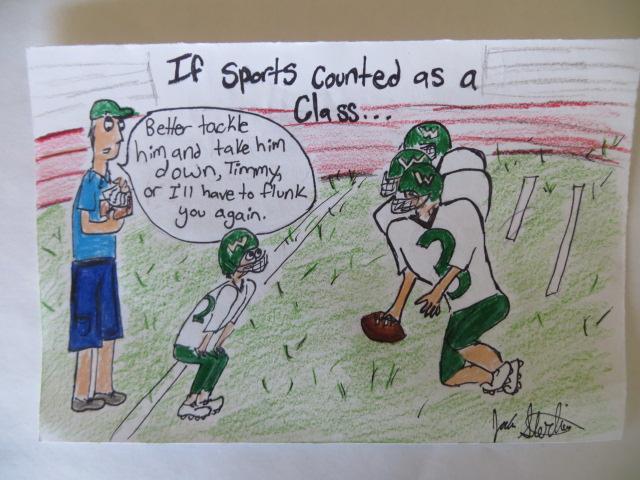The Student- Athlete Debate
April 13, 2015
Many students, it seems, from any school district, want to prioritize athletics during their high school career. This can make student-athletes forget about their schoolwork, and their grades can suffer. Ironically, this focus on athletics over academics can lead to the athlete getting put on academic ineligibility, and therefore, they can’t play their beloved sports. Really, it’s all a cycle.
Let’s take a look at the term “Student-Athlete.” Student comes first, because while in high school, and eventually college, students are expected to prioritize their academics. As many people know, you can’t play some sports forever. Eventually, if you don’t make it to the professional level of play, you have to go into a job and work for a living, just like so many other people in the world.
In Weedsport, we hold the policy that if you’re failing two or more classes for a five week span, you are on “probation,” where you must stay with the failing course’s teacher during tenth period, before going to practice. If you are still failing after 10 weeks, you are no longer eligible for the team, and you are immediately dismissed.
From what I can tell, many male Weedsport students really focus on football, and female students tend to focus on basketball. Let’s look at some numbers.
For male students, out of 1,071,775 athletes, a total of 61,252 athletes make it to all colleges (Division I, II, and III). An estimated only 5,000 make it to Division I, the colleges that are allowed to give out scholarships. So nearly 56,000 students have to pay to play their sport in Division II and Division III colleges. From those 61,000 students, only 250 students get drafted each year. Mostly all of them come from Div. I.
For female students, out of 452,929 athletes, a total of 15,096 athletes make it to all colleges. An estimated 2,000 athletes make it to Div. I colleges. Barely any schools put big money into female sports either. From those 15,000 students, only about 32 athletes are drafted into the WNBA – again, mainly coming from Div. I schools.
Even with the numbers, college recruiters for sports look at the big schools. In New York State terms, the Class AA and Class A schools, such as Jamesville Dewitt, Christian Brothers Academy, Skaneateles, Baldwinsville, and West Genesee. Unfortunately, they don’t look as often at Class D and Class C schools such as our own, even though we have great talent. Bigger schools mean bigger budgets, better equipment, and the cycle goes on and on.
Despite a few exceptions, Weedsport students barely stand a chance of getting looked at for full-ride scholarships, let alone getting accepted at all as a walk-on athlete. The only prominent exception Weedsport has ever known for getting major playing time in a Div I college is current Varsity football coach, Roger Jordan. He played for Tennessee University from 1980-1981 as a running back, before suffering a knee injury that sidelined him for his career.
Sure, we have those few promising athletes such as Austin Ashby, who went on to the University of Buffalo to compete in track and field, or Brad Wasilenko who went to Hartwick College to play football. We have many athletes that go to Div. III schools, to focus on academics and play sports as a side. Examples include Biz Chirco at Hobart William Smith College to play field hockey, Lucas Fitzgerald who went to the Rochester Institute of Technology to swim, or Mike Coolbaugh to play football at Rochester University.
Overall, students at Weedsport need to get their priorities straight and focus on their academics. Athletics are a fun hobby for most students, but many students make that their priority, and forget the fact that Weedsport is such a small school, and can’t compete against the large schools all across the country. Weedsport is known for it’s academics and it’s athletics for being such a small school, but academics should be known as the top priority.
